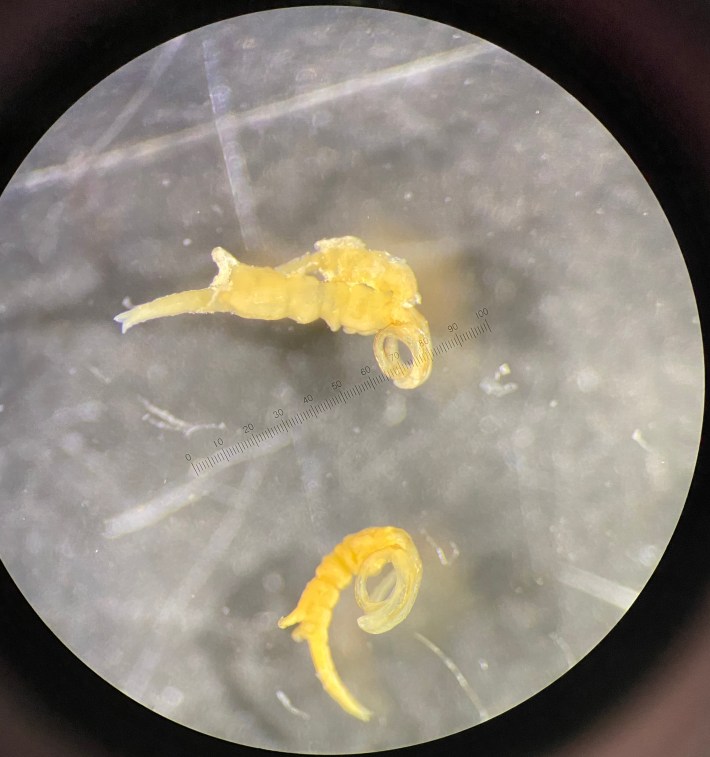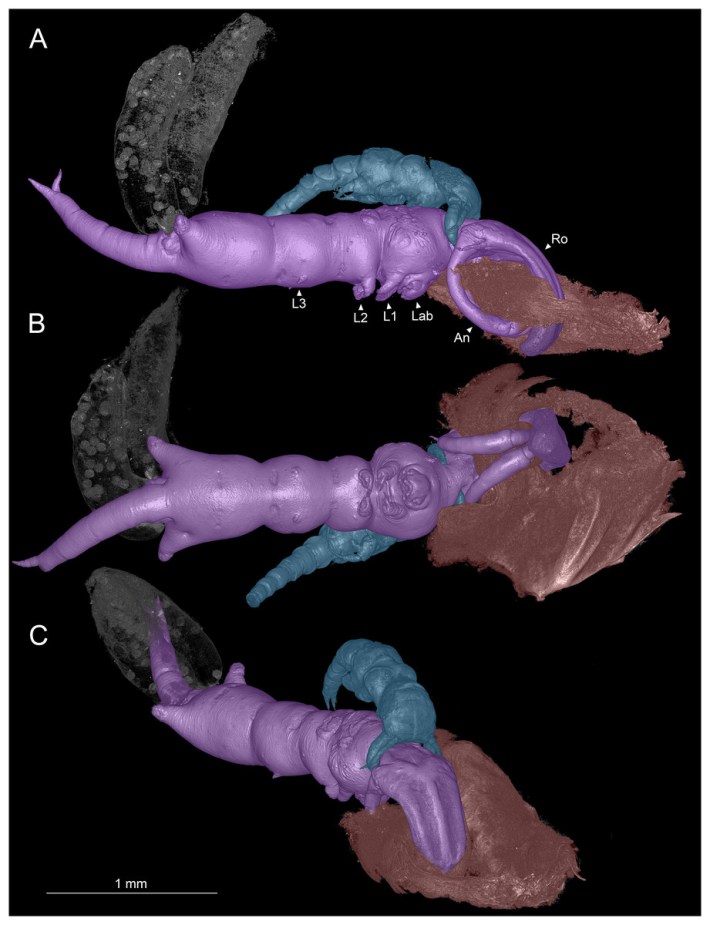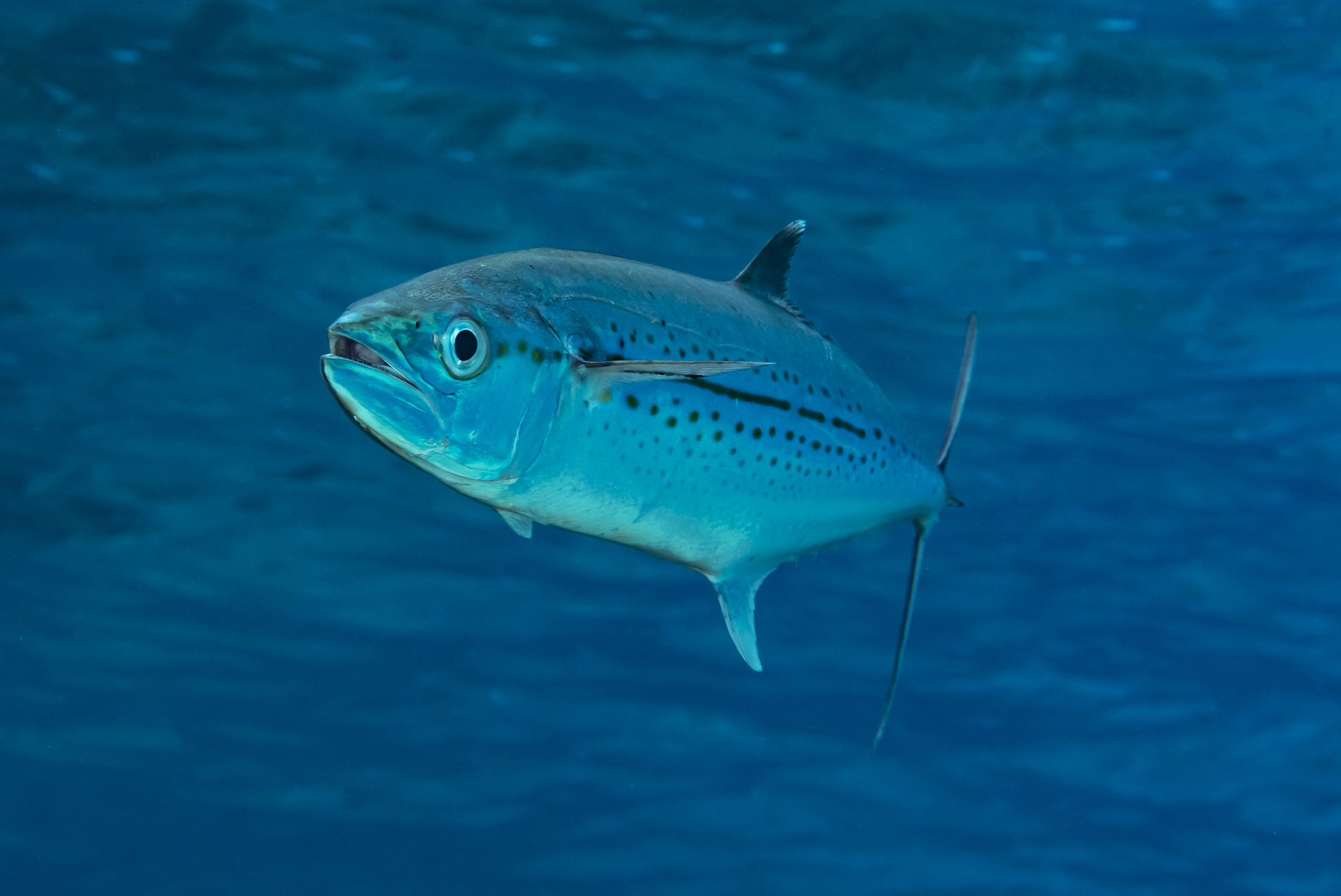We humans are fortunate to have many defenses against clogged nostrils. Our body contains all the tools we need to rid ourselves from boogers, such as a sneeze or finger, not to mention newfangled devices like neti pots and saline solutions. Other creatures are not so lucky. Fish have nostrils, which they use not for breathing but for smelling. But fish cannot sneeze (the only exception is the hagfish, a fish so famously slimy that it must "sneeze" out its slime-filled nostril to keep itself from choking), nor do they have fingers. "They have like absolutely no way of picking their nose," said Jimmy Bernot, an evolutionary biologist at the University of Connecticut.
This is a grave misfortune for fish, many of which must live with nostrils clogged not with boogers but parasitic copepods—small crustaceans that have evolved to cling to the insides of a fish's nasal passages. "I remember finding one small fish that had eight parasitic copepods in its nostril," Bernot said. "It was almost like an ant's nest, or, you know, termite colony, these tiny little white copepods crawling around this fish's nostril and there's really nothing the fish could do about it." But what is unfortunate for the host is fortunate for the parasite, and, as you may have guessed from the headline, this is not a story about fish. This is a story about parasitic copepods—specifically a very bizarre group called Shiinoidae, which dwell exclusively in fish nostrils thanks to their highly unusual anatomy, according to a new paper by Bernot and colleagues in PeerJ.
Copepods are ubiquitous in the world's oceans, lakes, rivers, wetlands, and ponds. Where there is water, there are probably copepods. "A free-living copepod typically looks like a small, shrimp-like creature that's about the size and shape of a sesame seed, or maybe a grain of rice," Bernot said. But many parasitic copepods, some of which can grow as big as the palm of your hand, have dispensed with the notion of even looking like a crustacean, taking on "all sorts of different blobby and wormy shapes," he said. These amorphous aberrations first inspired Bernot's interest in the crustaceans.

Bernot first learned about the family Shiinoidae eight or nine years ago, when he had just begun studying parasitic copepods. He knew the family was weird, as female shiinoid copepods have a giant, horn-like forehead, not unlike the horn of a rhinoceros beetle. But the parasites are so tiny, just a few millimeters long, that there were no good images of the species. Later, when he worked at the Smithsonian National Museum of Natural History, he got a chance to examine shiinoids up close, from specimens collected and described from the '60s to the '90s by the late researcher Roger Cressey. Then Bernot remembered the museum had just gotten a new micro CT scanner. "I thought, hey, let's put these in there and see what kind of images we could get," he said.
Two of Cressey's shiinoid specimens at the Smithsonian still clung to a hunk of gill-like tissue from inside the fish's nostril. "That was a kind of perfect way to, for the first time, look at how these copepods really hold on to their hosts in detail," Bernot said. The CT scans captured each of the copepod's tiny muscle bundles, which allowed the researchers to identify the creature's body segments and understand exactly how evolution had modified its body. Most copepods have clear body segments with interlocking ridges, like a cocktail shrimp, Bernot said. But the blobby, wormy parasitic copepods have often lost these hard ridges and other body parts in service of their unique lifestyle. A female shiinoids' body segments appear morphed together, almost like a cylindrical tube, and the parasites have lost their fourth and fifth sets of legs. And the legs she does retain are small and stubby.

But the strangest details were found on the copepod's face. The female's giant, horn, which curves downward, does not just grow out of her forehead; it is her forehead. "You can think of, like, an insect where they have their little antennae," Bernot said. "Imagine a giant forehead growing out from in between those antennae." The parasite's forehead horn can grow as long as a third of their body length, a trait not seen in any other copepod. In addition to the horn, the female copepod has two giant antennae that resemble elephant tusks, curving upward out of the front of her body. Together, the forehead horn and antennae tusks function like a jewelry clasp, allowing the female copepod to latch on to a nostril without any sustained exertion.
"I have seen some weird copepods, but this is for certain the weirdest," Heather Penney, an evolutionary ecologist at St. Francis Xavier University in Nova Scotia, Canada who was not involved with the research, wrote in an email. "The fact that there is an antenna [and] rostrum clamp that is so exaggerated and has evolved in only the female of the species is the most interesting aspect for me," she said.
If only the female shiinoids have evolved a forehead clasp, where does that leave the males? Fret not, as they actually have no need to attach to nostril flesh. Instead, they attach to the females. One of the Smithsonian's specimens had four copepods attached to a chunk of nasal passage, two females and two males, both of which were attached to the same female.

Scientists don't know much about the adolescence of these parasitic copepods. But Bernot is certain the copepods spend the early days of their life as other parasitic copepods do: swimming around as larvae in search of a host. Female shiinoids eventually grow larger than their male counterparts because their end goal is somewhat simple: finding a host and producing a lot of eggs. "Once they do find a host, they tend to grow quite large, because they're a small animal living on a big animal," Bernot said. "They have essentially all of the food they could ever eat in their life." But males have a more complicated task: finding not just any host, but one that has females. So the male shiinoid's anatomy is different. They retain more of their swimming legs because they likely have to do a lot more swimming. And "the male is attaching to the female, not the host tissue, so the male has a totally different system for holding on," Penney points out.
Many other aspects of these copepods' lives remain shrouded in mystery. How do they manage to swim up the nostril in the first place? How does a female's forehead horn develop as she molts into adulthood? And what other copepods is this strange family related to? Since no other copepods boast such a horn, "we really don't know what their relatives are," Bernot said. He wonders if the shiinoids are related to the many other species of nostril-dwelling copepods. "That would be really interesting if these are just a very derived, unusual group that has taken the nostril lifestyle in a really extreme direction," he said. It does seem strange that so many copepods live in the dark, comforting tunnel of a nasal passage yet only this group has a horn. "What is it about their host that selected this species to do this?" Penney asked.
Although Bernot could not think of another copepod, parasitic or not, that had evolved its head into a clasp, he dove into the literature in search of other potential animal clasps. The closest parallel he could find were Cretaceous hell ants, an extinct family of ants that lived about 100 million years ago and had a forehead clasp of their own that they likely used to pick up or grasp prey. Bernot sees it as a remarkable twinning of evolutionary trajectories in very distantly related animals. "These two groups independently through convergent evolution came up with some really wacky but very similar structures," Bernot said. "The ants are using it to catch insects. The copepods are using it to attach to fish nostrils."
Until another contender comes forward, female copepods in the Shiinoidae family, which contains just nine of the approximately 14,000 species of copepods, appears to be the only living animals with a clasp for a head—perhaps a dubious distinction, but a distinction nonetheless. Maybe with more study, the males will find a way to distinguish themselves.






